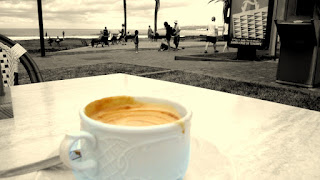 Thoughts at sea. These become parenthetical within the rhythm of the waves, the schedule of ports, the resting and relaxation--and the dreams. I report them here in a similar way.
Thoughts at sea. These become parenthetical within the rhythm of the waves, the schedule of ports, the resting and relaxation--and the dreams. I report them here in a similar way.Don Draper is, himself, his own invention. He is, therefore, Everyman or more pointedly, Nowhereman.
He is an idea man and his advertising firm is convinced of his brain-storms which flow like milk and honey from his ever-inebriated lips.
He produces a lot of ideas, but never has to execute them. Luckily, he has a staff of creatives who do this for him.
Which then/who's then, is the creative act?
Art is/creativity is/production is:
-
- concerned with the impulse of creativity and the proclivities of production.
- creative problem-solving is central to creative decision-making.
- a reflection/a record of the time/space/culture which we currently inhabit.
A Dream at Sea:
The House and the Swimming Pool
Trevor was building a swimming pool next to the post-modern, but definitely retro-modern holiday house that he had designed, much akin to Alain de Botton's contemporary holiday homes. We said that the pool should be at opposite angles to the house, but Trevor insisted on a parallel configuration. We said, "No, no, no! that cannot be right!"
He began to cry and shed his clothes. He looked like a happy Buddha, except that he was crying so he resembled a sad one. We tried to comfort him.
Two rectangles -- how to place them:
- side by side, length paralleling length
- T-square formation
Change of Scene: Old Japanese woman with greying hair in a bun. I was lying in the grass and finding minuscule flowers, purple and orange--the most outrageous of the opposites on the colour wheel.
I placed the flowers in the old woman's hair.
She then spoke, herself in a dream state:
"The pool should be placed next to the rectangular house like a woman lying next to a man, her curves forming the negative space between the two of them".
So the pool should be curvilinear, not a rectangle. It's length should mirror the length of the house, but it's emphasis remain the shapes created between the two.
My father was right.
Thanks Kip!
ReplyDeleteI like the reaction selections. Perhaps add more.
ReplyDelete